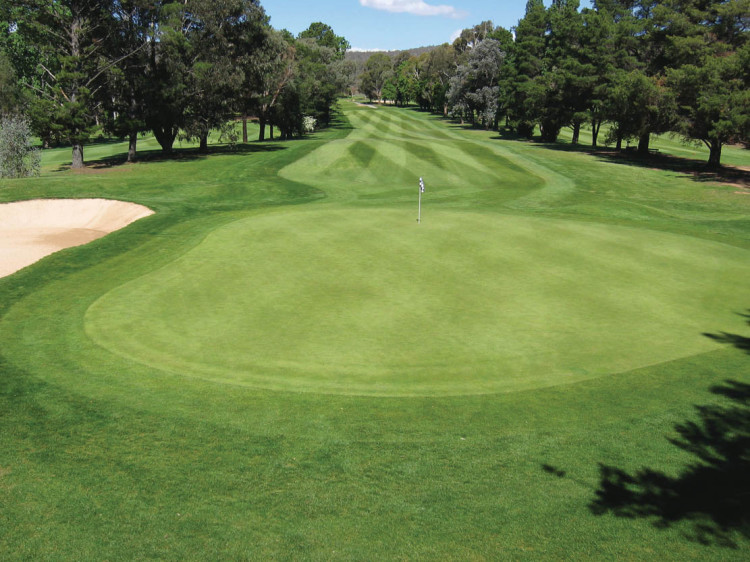What Is The Green In Golf

Golf is a sport renowned for its precision and meticulous attention to detail. Every aspect of the game is carefully crafted to provide a challenging yet rewarding experience for players. And at the heart of this intricate tapestry lies the enigmatic and revered element known as the green. In the world of golf, the green holds a special place, for it is here that dreams are realized, frustrations are born, and champions emerge.
But what exactly is the green in golf? It is more than just a patch of grass. It is the hallowed ground where the ultimate objective of the game is achieved – sinking the ball into the hole in as few strokes as possible. The green is a meticulously maintained putting surface, smooth and uniform, designed to test the golfer’s skill and judgment.
In this article, we will embark on a journey of exploration, unraveling the secrets of the green. We will delve into its physical characteristics, understand its significance in scoring, and unlock the art of putting. We will also discover the intricacies of green maintenance, the measurement of green speed, and the different types of greens found on golf courses.
So, join us as we step onto the verdant canvas that is the green in golf. Together, let us uncover the nuances, challenges, and beauty that make the green an integral part of this captivating sport.

The Green: The Putting Surface
The green in golf refers to the specifically manicured area where the flagstick and hole are located. It is the ultimate target for golfers, the place where they aim to sink their ball in as few strokes as possible. The green is different from the rest of the course, designed to provide a smooth and uniform surface suitable for putting.
A well-maintained green possesses certain physical characteristics that make it ideal for putting. These include:
- Smoothness and Evenness: The green should be free of bumps, indentations, or irregularities that could affect the roll of the ball.
- Grass Type and Length: Different types of grass, such as Bentgrass, Bermuda grass, or Poa annua, can be used on greens. The grass is typically cut shorter than the fairways, allowing for a faster roll.
- Shape and Size: Greens come in various shapes and sizes, often featuring contours and slopes to add challenge and strategy to the game.
Role of the Green in Golf
The green plays a pivotal role in golf, influencing the scoring, strategy, and overall experience of the game. Here are some key aspects that highlight the significance of the green:
A. Scoring Significance: The green is where the final strokes of each hole are made. The fewer strokes taken on the green, the lower the score. Mastering the art of putting is crucial for success in golf.
B. Putting and its Impact: Putting is a specialized skill that requires finesse, touch, and precise judgment. The green’s smooth surface and the golfer’s ability to read it directly impact their putting performance.
C. Navigating the Green: Reading the green involves analyzing its slopes, contours, and speed. Understanding these factors helps golfers determine the line and pace needed to sink their putts.
- Influence of Slopes and Contours: The slopes and contours of the green can significantly affect the ball’s path. Golfers must account for uphill, downhill, and side-to-side breaks when lining up their putts.
- Understanding the Speed of the Green: The speed of the green refers to how fast the ball rolls on its surface. Golfers need to adjust their stroke and anticipate the pace of the green to avoid overshooting or coming up short.
- Dealing with Obstacles on the Green: The green may have various obstacles, such as bunkers or water hazards, strategically placed to add challenge. Golfers must navigate these obstacles while aiming for the hole.
Maintenance of the Green
Maintaining the green in optimal condition is vital for providing golfers with a consistent and enjoyable putting surface. Golf course superintendents play a crucial role in ensuring the green’s health and playability. Let’s explore some techniques and practices involved in green maintenance:
A. Importance of Proper Green Maintenance: Regular and careful maintenance of the green promotes healthy turf growth, maintains consistent playing conditions, and helps prevent disease or pest infestations.
B. The Role of the Golf Course Superintendent: Golf course superintendents are responsible for managing the maintenance and care of the entire course, including the greens. They oversee various tasks, such as mowing, fertilizing, and watering, to maintain the green’s condition.
C. Techniques and Practices for Maintaining the Green:
- Mowing and Rolling: Regular mowing at precise heights keeps the grass on the green at an optimal length for smooth putting. Rolling the green with a heavy roller helps increase firmness and enhances ball roll.
- Aeration and Topdressing: To maintain healthy turf, aeration is performed to alleviate soil compaction and improve oxygen exchange. Topdressing, applying a thin layer of sand or soil, helps level the surface and enhance root development.
- Pest and Weed Control: Greenkeepers employ integrated pest management techniques to control pests and weeds without harming the environment. This may involve the targeted use of organic pesticides or biological controls.
By implementing these maintenance practices, golf course superintendents ensure that the green remains in optimal condition, providing a consistent playing surface for golfers.
Green Speed and Stimpmeter
Green speed refers to the velocity at which the ball rolls on the green surface. It can significantly impact a golfer’s putting strategy and execution. To measure green speed accurately, golf course maintenance staff often use a device called a Stimpmeter. Let’s take a closer look at green speed and the role of the Stimpmeter:
A. Definition of Green Speed: Green speed refers to the relative fastness or slowness of the ball’s roll on the green. Faster greens require more delicate touch and precision, while slower greens demand firmer strokes.
B. The Role of the Stimpmeter: The Stimpmeter is a tool used to measure green speed. It consists of a metal bar with a groove that allows the ball to roll smoothly. By measuring the distance a ball rolls when released from the Stimpmeter, course staff can determine the green’s speed.
C. Factors Influencing Green Speed:
- Grass Type and Height: Different grass species have varying growth patterns and characteristics, which can affect green speed. Lowering the height of the grass also increases the speed.
- Moisture Level: The moisture content on the green affects ball roll. Drier greens tend to be faster, while wetter greens slow down the ball.
- Weather Conditions: External factors such as temperature, humidity, and wind can influence green speed. Hot and dry conditions may lead to faster greens, while cooler or wetter conditions can slow them down.
Understanding the green speed and its influencing factors helps golfers adjust their putting techniques to adapt to different course conditions.
Different Types of Greens
Golf courses feature a variety of greens, each with its unique characteristics. The choice of grass and maintenance practices contribute to the overall playing experience. Here are some commonly found types of greens:
A. Traditional Grass Greens:
- Bentgrass Greens: Bentgrass greens are popular in many regions due to their fine texture and ability to withstand low mowing heights. They offer a smooth putting surface and are often found in cooler climates.
- Bermuda Grass Greens: Bermuda grass greens thrive in warmer climates and offer excellent durability. They are known for their ability to recover quickly from foot traffic and play.
- Poa Annua Greens: Poa annua, or annual bluegrass, is a common grass type found on greens. It can provide a good playing surface but requires careful maintenance to control its growth and prevent weed invasion.
B. Artificial or Synthetic Greens:
- Advantages and Disadvantages: Synthetic greens are made from artificial materials, such as synthetic turf or carpet-like surfaces. They offer consistent playing conditions, require minimal maintenance, and can be used in various climates. However, they may lack the natural feel and aesthetic appeal of traditional grass greens.
- Types of Synthetic Materials Used: Synthetic greens can be constructed using materials like nylon, polypropylene, or polyethylene. These materials are designed to simulate the characteristics of natural grass and provide a suitable surface for putting.
While traditional grass greens remain the most common choice for golf courses, the use of synthetic greens has gained popularity due to their convenience and cost-effectiveness in certain settings.
Etiquette and Rules on the Green
Respecting proper etiquette and following the rules on the green is essential to maintain a pleasant and fair golfing experience. Here are some guidelines to keep in mind:
A. Proper Behavior and Etiquette on the Green:
- Show respect for fellow golfers by avoiding distractions and unnecessary noise while they are putting.
- Repair ball marks and divots promptly to maintain the green’s quality and smoothness for subsequent players.
- Avoid walking on another player’s putting line to prevent potential damage to the green’s surface.
B. Repairing Ball Marks and Pitch Marks:
- When a ball lands on the green, it may create a depression known as a ball mark. Repairing ball marks promptly using a repair tool helps restore the smoothness of the green and ensures proper putting conditions.
- Pitch marks, caused by balls landing at a steep angle, should also be repaired to prevent long-term damage to the green.
C. Rules Governing the Use of the Putter on the Green:
- The rules of golf dictate that players should not use their putters to test the surface or tap down irregularities on the green before making a stroke.
- However, players can use their putters to remove loose impediments, such as leaves or twigs, that might affect their putting line.
Following these etiquette guidelines and adhering to the rules of golf on the green contributes to a respectful and enjoyable golfing atmosphere for all players.
Environmental Considerations
In recent years, golf courses have increasingly embraced sustainability initiatives and environmental practices. Greenkeepers and course management teams are taking steps to minimize environmental impact and conserve resources. Here are some environmental considerations related to golf greens:
A. Golf Course Sustainability Initiatives:
- Many golf courses are implementing sustainable practices, such as water conservation, energy-efficient irrigation systems, and use of renewable energy sources.
- Some courses participate in environmental certification programs to showcase their commitment to conservation and sustainability.
B. Water Conservation Practices on the Green:
- Golf courses are implementing water management strategies, such as using moisture sensors and weather data to optimize irrigation.
- Some courses utilize recycled water or capture and reuse rainwater to reduce reliance on freshwater sources.
C. Use of Organic Fertilizers and Pesticides:
- To minimize the environmental impact, golf courses are transitioning to organic or low-chemical input fertilizers and pesticides.
- Integrated pest management techniques, which prioritize biological controls and prevention, are increasingly employed to reduce reliance on chemical treatments.
By adopting these environmental considerations, golf courses aim to strike a balance between providing exceptional playing conditions and minimizing their ecological footprint.
Conclusion
The green in golf holds a special place in the game, serving as the ultimate destination for golfers and a platform for putting mastery. Understanding its importance, maintenance, speed, and variations adds depth to our appreciation of the sport. From the meticulously manicured grass to the challenges posed by slopes and contours, the green provides an ever-present test of skill and strategy.
Next time you step onto the green, take a moment to observe its characteristics, appreciate its role, and be mindful of the etiquette and environmental considerations associated with this sacred space in golf. Whether sinking a crucial putt or admiring the beauty of the surroundings, the green truly embodies the essence of the game. So, go ahead, tee up, and embrace the allure of the green in golf.





